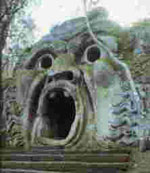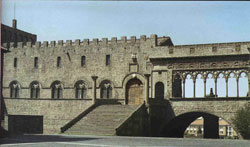|
|
The
Latium
 Latium
is a mysterious land. It is a land of woods and pastures, hills and valleys,
rivers and lakes, with as many as twenty-five nature parks and reserves. The
land is washed by a blue sea, with a whole archipelago lying just a few
miles off the coast. Latium
is a mysterious land. It is a land of woods and pastures, hills and valleys,
rivers and lakes, with as many as twenty-five nature parks and reserves. The
land is washed by a blue sea, with a whole archipelago lying just a few
miles off the coast.
It is a harsh land, which only seems to be unknown. In its heart lies Rome,
the Eternal City, which calls people from all over to see its Roman ruins,
Renaissance squares and baroque churches. Rome is a compendium, illustrating
the evolution of architecture from Roman times to the present day.
Latium is the region that surrounds the city which a frame that is all
history and landscape. The landscape is history in its own right, the
product of men and men's activities, their thoughts and their imaginatiion,
forming a symbiiosis of landscape, history and art. Hills and gorges, karst
caves and extinct volcanoes, cliffs and caves by the sea, are perhaps the
most artistic aspect of the work of nature; solitary sanctuaries and
tumble-down churches, dead towns and little villages perched on high spurs
of tufa, poles of art and faith bear witness to man's ascendancy over the
environment. And since man's work is commonly considered an art, we may say
that, in the variegated and complicated territory of Latium, man compares
well with nature, equalling its beauty.
Territory: The region, with undulated hills, stretches from the western
buttresses of the Apennines to the Tyrrhenian Sea. The landscape is varied
and presents flatlands, on the coastline and in the hinterland, ridges and
calcareous highlands. Latium has four very ancient volcanic distincts, where
the craters of extinct volcanoes form the lakes of Bolsena, Vico, Bracciano,
Albano and Nemi.
Cities: Rome, capital of Italy, as well of the region. Other important
cities are Frosinone, Latina, Viterbo and Rieti.
 Rome: Rome:
Cradle of the western civilization and the heart of Christianity, Rome is
the one city in the world that possesses the most masterpieces.
Under the wonderfully pure sky, the toll of some hundred bells breaks the
silence of its majestic and very ancient monuments, its narrow and shady
center streets, the small hidden squares, the gushing fountains, the
incredibly green gardens, the silent and enigmatic people and its millions
of marble statues.
The extraordinary richness of the artistic, historic, and religious
patrimony, the lively markets, the old gastronomic traditions and the "dolce
vita", render the Eternal City one of the main destinations of international
tourism.
 Frosinone: Frosinone:
Frosinone, ancient city founded by the Volsci on a hill overlooking the
plain of the river Sacco, is the historical capital of Ciociaria.
Despite its ancient origin, it is difficult to find traces of the past; many
changes have taken place during the centuries, many plunderings and, more
recently, the second World War has caused serious damage to the urban and
architectural layout of this city.
Yet Frosinone is today a pleasant and modern city, which deserves to be
visited and discovered through its streets, piazzas, monuments and
picturesque flowery spots.
Rieti:
Die Geschichte von Rieti beginnt in der Eisenzeit. Der Name von Rieti, das
älter ist als Rom, an dessen Schicksal es in den späteren Jahrhunderten
gebunden war, leitet sich ab von Rea, Mutter aller Götter. Rieti war das
wichtigste Zentrum der Verbreitung im Prozess der von den Sabinern seit dem
8. Jh. v. Chr. durchgeführten Kolonisierung. Eine Perle unter vielen aus dem
Kunstschatz von Rieti ist das Stadttheater Tito Flavio Vespasiano, das von
Kritikern und Experten als eines der schönsten Italiens auf dem Gebiet der
Theaterarchitektur betrachtet wird, vor allem wegen der hervorragenden
Akustik.
 Art:
Latium is the cradle of Roman civilization and it is incredibly rich in
outstanding relics of the different periods. The traces of the Etruscan
civilization are remarkable and can be found at Veio, Vulci, Tarquinia and
Cerveteri. The region has always been the center of an intensive artistic
life, which, from the Middle Ages to the eighteenth century, has had as
cardinal point the presence of the Church (the Vatican City, seat of the
papacy, is in the heart of Rome). Art:
Latium is the cradle of Roman civilization and it is incredibly rich in
outstanding relics of the different periods. The traces of the Etruscan
civilization are remarkable and can be found at Veio, Vulci, Tarquinia and
Cerveteri. The region has always been the center of an intensive artistic
life, which, from the Middle Ages to the eighteenth century, has had as
cardinal point the presence of the Church (the Vatican City, seat of the
papacy, is in the heart of Rome).
Museums: In Rome, the National Museum houses the most important archaeologic
collections in the world, while the Capitoline Museum holds the oldest
classic sculptures. In the Museum of the Palazzo dei Conservatori, Greek and
Roman sculptures. Etruscan vases, paleochristian sarcophagi can be admired.
The Pinacoteca Capitolina houses remarkables pictorial works. In the Museum
of Rome there are civic documents, from the Middle Ages to the present day.
Tourists should not omit a visit to the Barracco Museum, with Assyrian,
Babylonian, Egyptian and Etruscan relics arid to the National Museum of
Castel Sant’Angelo. The Doria Pamphili Gallery houses a highly valuable
private pictorial collection Moreover, there are: the National Gallery of
Ancient Art; the Borghese Museum and Gallery; the National Museum of Villa
Giulia. The imposing complex of the Vatican Museums contains numberless
outstanding masterpieces.
To be visited: In the center of Rome, we can admire the Roman Forum, the
imposing arid universally known Colosseum and the Cathedral of St. Peter.
Visitors can admire the archaeologic excavations, visit the quaint quarter
of Trastevere, go to Tivoli to see Villa Adriana.
Accomodations: B&B, Bed and Breakfast, hotels, apartments, lodging,
guesthouse, home rental, residence, villa, hotel, house for vacation,
hostels, camping
|
|
 |





